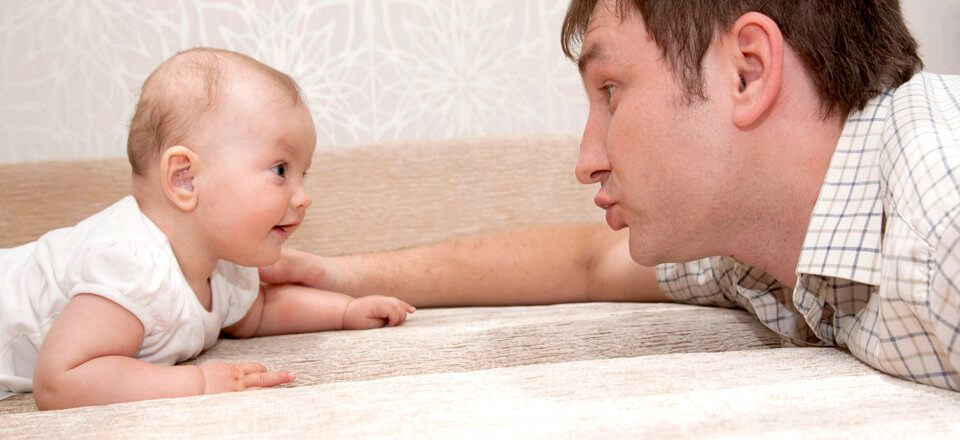| Helping Your Baby Learn to Talk | |||
| Babies learn an amazing number of things in their first two years, such as how to talk. Some start talking early, and others do not. Most late talkers are busy learning other things, but to be sure, ask a doctor, nurse practitioner, nurse or other professional about it, if your baby is not talking like other babies. This chart helps you decide when to ask. | |||
| Age | What to look for in a growing, healthy baby | Talk with a professional | |
| 3 months | Baby listens to your voice. He or she coos and gurgles and tries to make the same sounds you make. | ✓ If your 3-month-old does not listen to your voice. | |
| 8 months | Baby plays with sounds. Some of these sound like words, such as “baba” or “dada.” Baby smiles on hearing a happy voice, and cries or looks unhappy on hearing an angry voice. | ✓ If your 8-month-old is not making different sounds. | |
| 10 months | Baby understands simple words. She stops to look at you if you say “no-no.” If someone asks “Where’s Mommy?,” baby will look at you. Baby will point, cry or do other things to “tell” you to pick her up or bring a toy. | ✓ If your 10-month-old does not look when people talk to him or her. | |
| 12 months | First words! Baby says 1 or 2 words and understands 25 words or more. Baby will give you a toy if you ask for it. Even without words, baby can ask you for something—by pointing, reaching for it, or looking at it and babbling. | ✓ If your 1-year-old is not pointing at favorite toys or things he or she wants. | |
| 18 months | Most children can say “thank you” and at least 30 other words, and can follow simple directions like “jump.” | ✓ If your 18-month-old cannot say more than 5 words. | |
| 20 months | Your child can put 2 words together in a sentence, such as “car go,” or “want juice.” He can follow directions when you say things like “close the door.” He can copy you when you say several words together. | ✓ If your 20-month-old cannot follow simple commands such as “come to Daddy.” | |
| 24+ months | Your child adds endings to words, such as “running” or “played” or “toys.” She likes hearing a simple children’s story. She understands 3 words about place, such as “in,” “on” or “at.” | ✓ If your 2-year-old cannot say 50 words or does not use 2 words together. | |
|
Ideas to Help Your Child Learn to Talk |
||||||||||||
| When to start | Do the first activities as long as your child enjoys them. Add new activities as he or she grows older. | |||||||||||
| Birth |
Help your baby learn how nice voices can be.
|
|||||||||||
| 3 months |
Help your baby see how people talk to each other.
|
|||||||||||
| 6 months |
Help your baby understand words (even if he or she can’t say them yet).
|
|||||||||||
| 9 months |
Help your baby “talk” by pointing and using his or her hands.
|
|||||||||||
| 12 months |
Help your child say the words he or she knows.
|
|||||||||||
| 15 months |
Help your child talk with you.
|
|||||||||||
| 18 months |
Help your child put words together and learn how to follow simple directions.
|
|||||||||||
| 2 years |
Help your child put more words together. Teach your child things that are important to know.
|
|||||||||||

